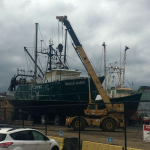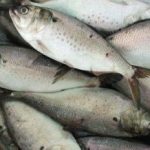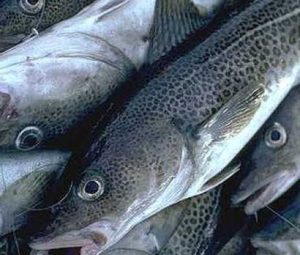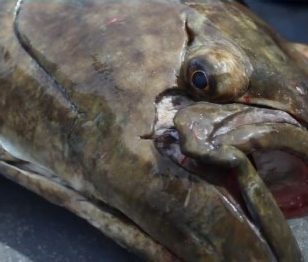Tag Archives: Asian carp
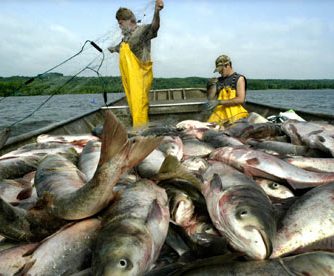
Eating the Most Hated Fish on the Mississippi
The presence of silver carp in the Mississippi dates back to the 1960s, when scientists in Arkansas brought a few different species of Asian carp into the country to see if they might offer a chemical-free way to clean algae out of fish ponds. When funding for the experiment dried up, the fish were released to the waterways and swiftly began outcompeting local fish. Today Asian carp—mostly bighead, silver, and grass carp—make up 90 percent of the biomass in parts of the Ohio and Mississippi rivers.,, One of the biggest challenges for Fin, Schafer, and Two Rivers is finding enough fishermen. Commercial river fishing is a dwindling industry along many parts of the Mississippi and Ohio,,, >click to read<14:46
Kentucky Awards First-Ever Fish House Contract to Fight Asian Carp
 Gov. Matt Bevin today announced the award of the state’s first-ever fish house contract, in an innovative step to attack the Asian carp problem in western Kentucky and encourage job growth in the region..,, The Kentucky Department of Fish and Wildlife Resources is pledging up to $4 million in loans and incentives for the fish house and commercial fishermen.,, “Commercial anglers currently harvest two million pounds of Asian carp from Kentucky’s waters each year,” said Ron Brooks, Kentucky Fish and Wildlife’s fisheries director. “We believe this program can increase that catch to 20 million pounds across the state within the next five years.” >click to read<13:13
Gov. Matt Bevin today announced the award of the state’s first-ever fish house contract, in an innovative step to attack the Asian carp problem in western Kentucky and encourage job growth in the region..,, The Kentucky Department of Fish and Wildlife Resources is pledging up to $4 million in loans and incentives for the fish house and commercial fishermen.,, “Commercial anglers currently harvest two million pounds of Asian carp from Kentucky’s waters each year,” said Ron Brooks, Kentucky Fish and Wildlife’s fisheries director. “We believe this program can increase that catch to 20 million pounds across the state within the next five years.” >click to read<13:13 

Canadian fishermen want cheaper lobster bait. Americans want to stop an invasive fish. And so, one man hatches a plan
Like whales breaching ocean swells, silver carp fly out from beneath the surface of waterways in Illinois. Tens of millions of dollars have been spent trying to keep the invasive fish – which procreate rapidly, crowding out other marine life – from spilling into the $7-billion Great Lakes fishery. And in an era of expeditious information-sharing, the “flying fish,” a form of Asian carp imported into the States decades ago, with hopes of using them to manage American ecosystems, have also caught the attention of gawking social-media spectators around the world. Three years ago, one of those spectators was a Nova Scotian named Patrick J. Swim. But instead of merely gawking, the self-described “lobsterpreneur” hatched a plan: >click to read<12:32
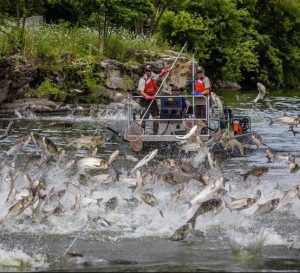
As Asian Carp Invade Tennessee, State Asks Fishermen To Help Fight Back
The scale of the asian carp problem has gotten considerably worse in recent years as the invasive species moves further into Tennessee. The state Wildlife Resources Agency is developing a plan to keep the carp contained and eventually push them back. The agency is working with other states and the federal government to sponsor fishing tournaments, create incentives for commercial fishermen and test out new technology to keep the carp from spreading out of West Tennessee. The agency is funding a $500 thousand program to develop new markets for the carp beyond fertilizer, like getting more of them into restaurants. >click to read<15:26
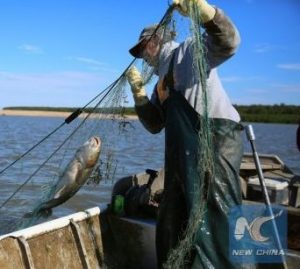
Carp Conundrum: Too Many Fish, Not Enough Fishermen
Two Rivers Fisheries in west Kentucky has more than doubled its Asian carp processing since it opened in 2013. Employees at the Wickliffe fishery are working on a load of silver carp caught by contracted commercial fishermen. The crates of fish represent a small amount of the more two million pounds that Two Rivers processes. “We need at least 10 groups of full-time commercial fishermen, ”,,, “I’ve got fishermen here that are making $2,000 to $3,000 a week… We are trying to get people to start fishing for this fish because this fish is here to stay and we are here to stay.” >click to read<16:22

Chinese business brings prosperity to fishermen on Mississippi
After less than 10-minute cruising on the Mississippi River in west Kentucky, Mark Buttler stopped his boat near a shoal and began to cast nets. He harvested 400 pounds of fish from two fishnets on this bright autumn morning. For the 62-year-old fisherman, who joined his father for fishing soon after high school graduation in the westernmost part of the U.S. state of Kentucky, the daily routine also includes selling his catch to a local business run by a Chinese entrepreneur. Before 2013, he sold his fish either to a market up north or to a seafood restaurant in Ledbetter, Kentucky. Then Angie Yu came to the City of Wickliffe in west Kentucky and opened the Two Rivers Fisheries to process fish from the Mississippi. Yu’s efforts also coincide with the U.S. government’s eagerness to remove some of the Asian carp from the river. click here to read the story 17:53
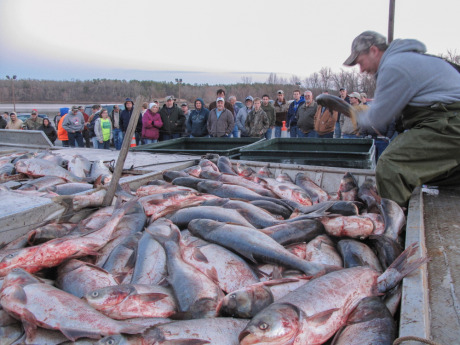
Kentucky State Fish and Wildlife Department seeking input on entrepreneurial solutions for Asian carp problem
Asian carp swim by the millions in Kentucky’s waterways, threatening to crowd out native fish in some of the state’s most cherished fishing destinations – including Kentucky and Barkley lakes in the west. With an absence of predators and little natural controls available for these invasive species, the Kentucky Department of Fish and Wildlife Resources, the state Tourism, Arts and Heritage Cabinet and the Commonwealth of Kentucky are seeking public input on a plan to limit the explosive growth of Asian carp populations while providing a valuable protein source for people. State officials will evaluate a potential public/private partnership to boost the emerging Asian carp fish processing business in Kentucky. State support of entrepreneurs could include hiring commercial anglers and rental of necessary equipment; supplying freezer space in warehouses; purchasing catches during low demand times; and cash incentives, among other potential solutions. click here to read the story 08:30
Progress made on invasive Asian carp in Kentucky thanks to Commercial Fishermen
 Asian carp have been a big problem in our state. For years now, the KDFWR has worked with commercial fisherman, private fish processors and others in efforts to remove the Asian carp from our waters. Since 2015, three processors have been established, and their facilities have led to the harvest of more than 1.2 million pounds of Asian carp in 2015; more than 800,000 pounds from Kentucky and Barkley lakes. These processors are putting a big dent into this large population and are taking a fish that is unwanted in our waterways and putting them to use by processing them into food to ship overseas. In March, Two Rivers Fisheries in Wickliffe announced it was expanding. The plant doubled production in the past year, processing more than four million Asian carp to ship the fillets overseas and to use in fertilizers. click here to read the story 10:32
Asian carp have been a big problem in our state. For years now, the KDFWR has worked with commercial fisherman, private fish processors and others in efforts to remove the Asian carp from our waters. Since 2015, three processors have been established, and their facilities have led to the harvest of more than 1.2 million pounds of Asian carp in 2015; more than 800,000 pounds from Kentucky and Barkley lakes. These processors are putting a big dent into this large population and are taking a fish that is unwanted in our waterways and putting them to use by processing them into food to ship overseas. In March, Two Rivers Fisheries in Wickliffe announced it was expanding. The plant doubled production in the past year, processing more than four million Asian carp to ship the fillets overseas and to use in fertilizers. click here to read the story 10:32

REWARD!! Michigan DNR Offers Big Reward For Plan To Block Invasive Fish
If the fishing world had a most-wanted list, Asian carp surely top it. There are plenty of despised invasives plaguing U.S. waters, but how many of them have a $1 million dollar bounty on their heads? That’s what the Michigan Department of Natural Resources just dropped on the table. Show the agency a viable plan for stopping those silver and big head carp from reaching the Great Lakes and you could be eligible for a sweet payday. In case you haven’t already heard the tale, Asian carp are prolific breeders that can reach 50-pounds. The filter-feeding invasives consume massive amounts of the tiny plants (phytoplankton) and animals (zooplankton) that feed native forage species, along with juvenile sport fish such as walleye and yellow perch. Disrupting the food web can wreak havoc on local fisheries. Read the story here with link to DNR 12:21
What a surprise! Fishermen can catch grass carp, but government scientists can’t!
 Despite Quebec’s investment of $1.7 million to tackle a possible grass carp invasion, scientists have yet to locate any specimens themselves. Quebec’s Forests, Wildlife and Parks Ministry was quick to roll out a plan to combat the invasive species after two fishermen in the Lanaudière region caught a 29-kilogram grass carp in the St. Lawrence River May 27. Government scientists’ subsequent fishing expeditions have taken place in the Contrecœur area, about 60 kilometres northeast of Montreal. Tuesday, the ministry announced they have come up empty-handed. At this stage, laboratory tests are underway to determine the presence of grass carp DNA in the St. Lawrence River, sampling water from different areas. Those results will be available at the beginning of July. The grass carp is a type of Asian carp. The one that was caught in the St. Lawrence River was estimated to be between 15 and 30 years old. link 10:17
Despite Quebec’s investment of $1.7 million to tackle a possible grass carp invasion, scientists have yet to locate any specimens themselves. Quebec’s Forests, Wildlife and Parks Ministry was quick to roll out a plan to combat the invasive species after two fishermen in the Lanaudière region caught a 29-kilogram grass carp in the St. Lawrence River May 27. Government scientists’ subsequent fishing expeditions have taken place in the Contrecœur area, about 60 kilometres northeast of Montreal. Tuesday, the ministry announced they have come up empty-handed. At this stage, laboratory tests are underway to determine the presence of grass carp DNA in the St. Lawrence River, sampling water from different areas. Those results will be available at the beginning of July. The grass carp is a type of Asian carp. The one that was caught in the St. Lawrence River was estimated to be between 15 and 30 years old. link 10:17
Asian carp in the St-Lawrence threatens Quebec’s fishing industry
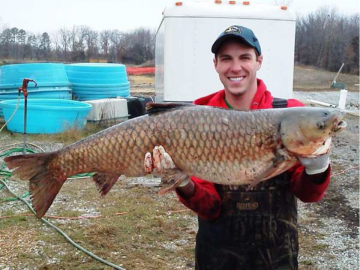 If you’ve seen the videos of boaters laughing uproariously as their motors startle giant Asian carp that leap high in the air and even into their boats, you might think it’s fun news that a 29-kilogram Asian carp was recently fished out of the St-Lawrence River. It’s not. The discovery of a single grass carp, one of four Asian carp species that have invaded several waterways in the United States in recent decades, near Contrecoeur last month could spell disaster for other fish, waterfowl and various species in the St-Lawrence River, and the waterways connected to it, as well as Quebec’s fishing industry. Here is a primer on Asian carp and why they’re so worrisome. Read the rest here 20:43
If you’ve seen the videos of boaters laughing uproariously as their motors startle giant Asian carp that leap high in the air and even into their boats, you might think it’s fun news that a 29-kilogram Asian carp was recently fished out of the St-Lawrence River. It’s not. The discovery of a single grass carp, one of four Asian carp species that have invaded several waterways in the United States in recent decades, near Contrecoeur last month could spell disaster for other fish, waterfowl and various species in the St-Lawrence River, and the waterways connected to it, as well as Quebec’s fishing industry. Here is a primer on Asian carp and why they’re so worrisome. Read the rest here 20:43
Commercial fisherman pulls a grass carp from his net in Lake Erie
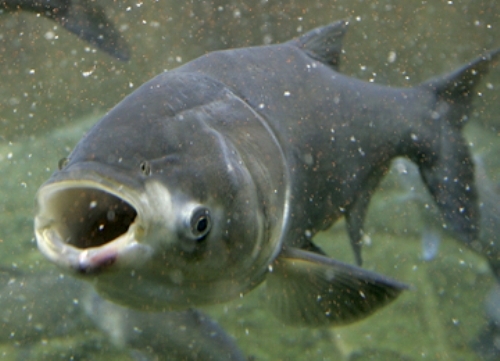 On Thursday, September 17, 2015 a commercial fisherman had an interesting find when he pulled a grass carp from his net in Lake Erie .The Grass carp is a species of the Asian carp, which feeds on aquatic vegetation. The fish was caught west of Point Pelee Thursday morning and weighed in at about 23 pounds (10.5 kilograms), though they have been known to grow upwards of 99 pounds (45 kilograms). The carp was sent to the Department of Fisheries and Oceans in Burlington for testing. This specific testing will include whether the fish was fertile or sterile,,, Read the rest here 12:22
On Thursday, September 17, 2015 a commercial fisherman had an interesting find when he pulled a grass carp from his net in Lake Erie .The Grass carp is a species of the Asian carp, which feeds on aquatic vegetation. The fish was caught west of Point Pelee Thursday morning and weighed in at about 23 pounds (10.5 kilograms), though they have been known to grow upwards of 99 pounds (45 kilograms). The carp was sent to the Department of Fisheries and Oceans in Burlington for testing. This specific testing will include whether the fish was fertile or sterile,,, Read the rest here 12:22
SECURE THE BOARDER! Asian carp discovery in Toronto prompts swift response
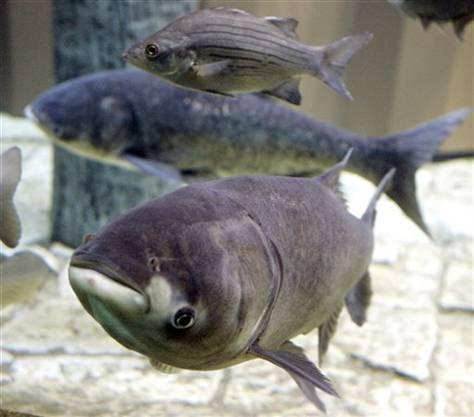 Canadian officials have moved quickly after an invasive species of fish was spotted in ponds in Toronto. It’s one of the largest responses ever against Asian carp. “We’re seeing an invasion happening in the U.S., so we can see the devastation that these species are having. We’re seeing native species pushed out for food and space, we’re seeing loss of habitat in wetlands areas and we’re seeing declines in commercial fishery values,” said Becky Cudmore, manager of the Asian Carp program. “Those are the type of impacts that these Asian carp species are,,, Read the rest here 14:03
Canadian officials have moved quickly after an invasive species of fish was spotted in ponds in Toronto. It’s one of the largest responses ever against Asian carp. “We’re seeing an invasion happening in the U.S., so we can see the devastation that these species are having. We’re seeing native species pushed out for food and space, we’re seeing loss of habitat in wetlands areas and we’re seeing declines in commercial fishery values,” said Becky Cudmore, manager of the Asian Carp program. “Those are the type of impacts that these Asian carp species are,,, Read the rest here 14:03
To tame the invasive Asian Carp, local chef pitches processing plant
 Plopping a 25-pound Asian carp in all its glorious ugliness onto a table in the middle of a conference room is a sure-fire way to get an audience’s attention. For Chef Philippe Parola it is the start of a familiar pitch: find a way to facilitate the consumption of the invasive species before it wrecks freshwater ecosystems in Louisiana, much as it already has in the upper Mississippi River valley. Read the rest here 07:55
Plopping a 25-pound Asian carp in all its glorious ugliness onto a table in the middle of a conference room is a sure-fire way to get an audience’s attention. For Chef Philippe Parola it is the start of a familiar pitch: find a way to facilitate the consumption of the invasive species before it wrecks freshwater ecosystems in Louisiana, much as it already has in the upper Mississippi River valley. Read the rest here 07:55
Emerging Fishery: Asian Carp nuisance seen as growth industry
 “The best way to control anything is to eat it up,” said Luu at her company in Ledbetter, on the outskirts of Paducah. “This is the second most consumed species of fish in the world. As a result, we can save our other species of fish.” Her company markets the carp as “Kentucky Blue Snapper,”,. She hopes to create 60 jobs paying about $10 an hour after receiving state approval last month to receive up to $1 million in state tax incentives. Another $4 million in similar state aid has been approved for two other nearby carp processors since 2013. Read the rest here 11:25
“The best way to control anything is to eat it up,” said Luu at her company in Ledbetter, on the outskirts of Paducah. “This is the second most consumed species of fish in the world. As a result, we can save our other species of fish.” Her company markets the carp as “Kentucky Blue Snapper,”,. She hopes to create 60 jobs paying about $10 an hour after receiving state approval last month to receive up to $1 million in state tax incentives. Another $4 million in similar state aid has been approved for two other nearby carp processors since 2013. Read the rest here 11:25
Asian carp chili or carp burgers, anyone?
 Although Asian carp filets are too bony for most U.S. consumers, boneless minced carp can be used as healthy stand-in for ground beef in some recipes. A recent University of Missouri blind taste test found that Asian carp rated higher than catfish. Asian carp chili, anyone? It may not sound appealing at first, but Dr. Mark Morgan at the University of Missouri has received rave reviews for his unique chili on several occasions. Read the rest here 17:17
Although Asian carp filets are too bony for most U.S. consumers, boneless minced carp can be used as healthy stand-in for ground beef in some recipes. A recent University of Missouri blind taste test found that Asian carp rated higher than catfish. Asian carp chili, anyone? It may not sound appealing at first, but Dr. Mark Morgan at the University of Missouri has received rave reviews for his unique chili on several occasions. Read the rest here 17:17
Illinois company latest to test market for carp
 When they arrive at the processing plant, the fish that have been cursed as a menace to American lakes and rivers are raked onto a conveyer belt, some of them still flopping. Brought by the boatload to this facility north of St. Louis, the Asian carp quickly meet a gruesome fate: They are ground to a bloody pulp in a maze of machines that churn their bony bodies into dehydrated meal and fish oil. Read more here 20:22
When they arrive at the processing plant, the fish that have been cursed as a menace to American lakes and rivers are raked onto a conveyer belt, some of them still flopping. Brought by the boatload to this facility north of St. Louis, the Asian carp quickly meet a gruesome fate: They are ground to a bloody pulp in a maze of machines that churn their bony bodies into dehydrated meal and fish oil. Read more here 20:22
Asian Carp vs. Commercial Fishermen: 2.5M lbs of now out of Illinois
It’s been four years since the discovery of an Asian carp between the electric barriers and Lake Michigan. That’s when the state went into emergency mode. They hired a select group of Illinois commercial fishermen. Video, Read more here 07:53
Asian carp invasion a growing problem
 No one really dreams anymore of completely ridding the Wabash River of invasive, destructive — and, let’s be honest, ugly-looking — Asian carp, a voracious breed of fish that grows quickly, reproduces rapidly and vacuums up so much microscopic plankton that it can starve out native species higher up the food chain. Read more here 11:26
No one really dreams anymore of completely ridding the Wabash River of invasive, destructive — and, let’s be honest, ugly-looking — Asian carp, a voracious breed of fish that grows quickly, reproduces rapidly and vacuums up so much microscopic plankton that it can starve out native species higher up the food chain. Read more here 11:26
Asian Carp more than just a nuisance for Illinois River fisherman – video
PEORIA, Ill. — The Asian Carp was introduced to American fisheries in the 1970s in an attempt to help to clean up the water. They have since invaded the Illinois River. It is the heart of spawning season, and fisherman say the fish are out of control. Read more here 10:08
Plans for a local Asian Carp processing center are on the way
EAST PEORIA, Ill. — Local leaders, international entrepreneurs, and local businesses are cooking up a plan to control the invasion of Asian Carp in the Illinois River. Ten entrepreneurs in China have expressed interest in bringing an Asian Carp processing center to the Peoria area. Read more here 22:29
Asian carp invasion headed our way
 Most sport fishermen are bitterly opposed to commercial fishing with nets. Many think their nets harm game fish populations. But the day might be coming when sport fishermen wish there were more commercial fishermen. Asian carp have invaded the lower reaches on the Tennessee,,, Read more here nooga.com 11:13
Most sport fishermen are bitterly opposed to commercial fishing with nets. Many think their nets harm game fish populations. But the day might be coming when sport fishermen wish there were more commercial fishermen. Asian carp have invaded the lower reaches on the Tennessee,,, Read more here nooga.com 11:13
Peoria processing facility suggested as means to battle Asian carp
 Perhaps the private sector can succeed where the government has failed. That seemed to be the theme following a summit-type meeting on Asian carp held at the Peoria County Courthouse Wednesday morning. more@thestreet 14:19
Perhaps the private sector can succeed where the government has failed. That seemed to be the theme following a summit-type meeting on Asian carp held at the Peoria County Courthouse Wednesday morning. more@thestreet 14:19
Tiny number of Asian carp could be big problem for the Great Lakes
 “This species will have a huge impact on the food web,” says Professor Cuddington. “Not only is it a fast-growing fish physically, but the population itself grows very quickly. A female can lay well over a million eggs a year, and with no known predators present in the Great Lakes, the Asian carp could dominate the waters and impact fisheries.” [email protected] 10:48
“This species will have a huge impact on the food web,” says Professor Cuddington. “Not only is it a fast-growing fish physically, but the population itself grows very quickly. A female can lay well over a million eggs a year, and with no known predators present in the Great Lakes, the Asian carp could dominate the waters and impact fisheries.” [email protected] 10:48
Local investors have received approvals needed to move full speed ahead on a $3.1 million fish Asian Carp rendering plant

The plant primarily will render Asian carp for high-protein supplement products, but can render any fish caught by commercial fishermen contracted to bring in fish for the operation. continued@thetelegraph
U.S. plan to fight Asian carp includes electronic barriers, water guns and love potions! Why not let NMFS take care of it? They know how to make fish disapear!
“This strategy continues our aggressive effort to bolster our tools to keep Asian carp out of the Great Lakes while we work toward a long-term solution,” said John Goss of the White House,,,continued@ctvnws
Paris, Tennessee. Where they WANT you to overfish! The only drawback is getting paid.

A variety of options to deal with the carp — many of which require a collaboration between state and area government leaders as well as commercial fishermen — have been suggested by experts.
Star editorial: Stopping Asian carp
The latest news about Asian carp isn’t good. In fact, it’s alarming. According to a report from the U.S. Geological Survey, the invasive and destructive fish may be able to spawn in far more of the Great Lakes’ tributaries including rivers in our region — than was first thought. continued@windsorstar
Serving up Asian Carp
 It’s survival of the fittest for fish in the Mississippi and Illinois Rivers. Asian Carp, a non-native fish, are rapidly multiplying and threatening other species of fish. Now Shafer fisheries in Thomson, Illinois is harvesting them. They’re catching an average of 80,000 lbs. of asian carp a week, and they’re cashing in on this fish with a bad rep. “We’re pretty much the only ones left,” said Owner Michael Shafer. Shafer said times are definitely changing in the commercial fishing industry. continued
It’s survival of the fittest for fish in the Mississippi and Illinois Rivers. Asian Carp, a non-native fish, are rapidly multiplying and threatening other species of fish. Now Shafer fisheries in Thomson, Illinois is harvesting them. They’re catching an average of 80,000 lbs. of asian carp a week, and they’re cashing in on this fish with a bad rep. “We’re pretty much the only ones left,” said Owner Michael Shafer. Shafer said times are definitely changing in the commercial fishing industry. continued



































